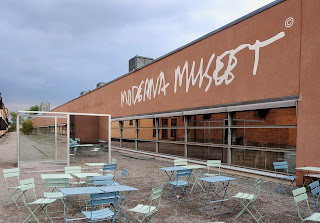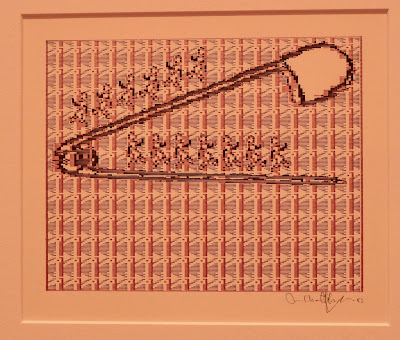ストックホルム旅行
2019年8月28日~9月4日 Stockholm Trip 28th of August ~ 4th of September, 2019 |
 |
Moderna Museet
ストックホルム近代美術館
Stockholm Museum of Modern Art
|
目次 / Contents
1) 現代美術 / Contemporary Art
2) "デルタ・ウプシロン" / "Delta Upsilon"
3) 現代美術の巨匠達 / Masters of Contemporary Art
A. ジャクソン・ポロック / Jackson Pollock
B. ジャン・デュビュッフェ / Jean Dubuffet
1) 現代美術 / Contemporary Art
タイトルは、"ボーイスカウト"、二段ベッドで、向き合っている、二人のアーティスト: の共同制作....そう説明されたら、なんとなく、何を表現したかが、察しがつきます。
私の推測では、作品は思春期に気が付く、同性への性的目覚め、その葛藤を表現しています。
デンマークのアーティスト、マイケル・エルムグリーン / Michael Elmgreen (1961 ~)とノルウェーのアーティスト、インガード・ラッグセット/ Ingar Dragset (1969 ~) は、1995年から共同制作をしています。
現在二人は、ベルリンに住んでいます。
"ボーイスカウト"の美術館の説明は、下記。
(訳は私なので、その理解が正確かは疑問です。原文はのちに載せています)
"キリスト教の価値観と軍事組織に基づく、スカウトは世界最大の青年運動の1つになりました。
ボーイスカウトは、若い男の子を、社会の責任ある一員にし、異性愛規範を持つ、良き父親に育てます。
女の子への興味は、遠くにあります。
思春期の性的目覚めの間、誘惑は避けられるべきです。
しかし、その環境で自分の性別に惹かれたらどうなりますか?
誰かとベッドを共有することは性行為の可能性を意味しますが、二段ベッドの狭い寝床は事実上、二人の間の過度の親密さ(肉体関係)との葛藤を意味します。
エルムグリーン&ドラッグセットは、ベッドを互いに向ける無謀な表現で、想像力の中だけでありえる新しい機会を見せました。"
ありえない状況と想像力に頼っての解決方法は、裏を返せば、現実世界での解決方法は、ないに等しいことを揶揄していると私は理解しました。
彼らの作品は、葛藤に苦しむ少年たちへの理解を広め、結果、彼らへの救済をしていると思います。
現代美術は、見ただけでの感想で良いという考え方があります。
創作者でない鑑賞者は、その考えで良いと思います。
ですが、創作に携わっている立場で、その姿勢である場合、私は、その姿勢は、現代美術を否定的に捉えている創作者の中にあると感じています。
現代美術の観賞時に全く思考・思想の理解を無視してしまっては、現代美術を愛することからも理解することもからも離れてしまうと思います。
現代美術への理解は、特に最近の現代美術は、アーティストの思考や概念を知らずしては難しいと私は感じます。
作品の背景を知ることが理解へつながると私は思うのです。
もちろん、1つ1つの作品に目を止めること、考えることは必要ありません。
私は理解力、思考力、知識がかけているので、気になった作品については、美術館の説明や一般的に認識されている事柄を参考にします。
最終的に自分の考えをもてれば、良いと思いますし、それが単純な言葉で表現されれば、その時点では、自分としては最も満足ができます。
 |
| "ボーイスカウト"、2008 エルムグリーン&ドラッグセット / Elmgreen & Dragset 作 二人のアーティストの合作です。 この作品も、Wikiで知ることができる作品も、私は好きです。 "Boy Scout", 2008 By Elmgreen & Dragset It is a joint work between two artists. I like this work and the works that can be found on the Wiki. ★ |
Contemporary Art
The title is "Boy Scout", a bunk bed, facing each other, co-produced by two artists .... after that, it makes me guess what the work expresses.
My guess is that the work expresses puberty awareness, sexual awakening to homosexuality, and the struggle.
Danish artist Michael Elmgreen (1961 ~) and
Norwegian artist / Ingar Dragset (1969 ~) have been collaborating since 1995.
Norwegian artist / Ingar Dragset (1969 ~) have been collaborating since 1995.
Currently the two live in Berlin.
According to their explanation by the Museum's website,
"Based on Christian values and military organisation, the Scouts have become one of the world’s largest youth movements. The Boy Scouts raise young boys to become responsible members of society and good, heteronormative fathers.
The distraction of girls is kept at a distance.
Temptations are to be avoided during the sexual awakening of puberty.
But what happens if you are attracted by your own gender in that environment?
Sharing a bed with someone means the possibility of sexual activities, but the narrow berths of a bunkbed effectively combats excessive intimacy between two people.
In a subversive gesture, Elmgreen & Dragset have turned the beds towards each other, opening up for new opportunities, if only in the imagination."
I understood that the solution that relies on the impossible situation and the imagination, on the other hand, is the solution in the real world is almost nothing.
I think their work promotes an understanding of the boys who are suffering from conflict, and as a result, the work provide help to them.
There is the idea that just looking at contemporary art is enough.
Viewers who are not the creators should think that way.
However, when people are in the position of being engaged in creative work, and the people have that attitude, I feel that it is among the creators who negatively perceive contemporary art.
If you completely ignore your understanding of thoughts and ideas when viewing contemporary art, you will be separated from love and understanding for contemporary art.
I think understanding contemporary art is difficult without knowing the artist's thoughts and concepts.
I feel that understanding contemporary art, especially the latest contemporary art, is difficult without knowing the artist's thoughts and concepts.
I feel that understanding contemporary art, especially the latest contemporary art, is difficult without knowing the artist's thoughts and concepts.
In my view, understanding the background of the work will lead to understanding.
Of course, we don't have to stop and think about each piece.
Since I lack understanding, thinking and knowledge, I refer to the museum's explanations and others for the works that interest me.
Eventually, I think it's good if I have my own thoughts, and if it's expressed in simple words, then I will be most satisfied with it.
Eventually, I think it's good if I have my own thoughts, and if it's expressed in simple words, then I will be most satisfied with it.
2) "デルタ・ウプシロン" / "Delta Upsilon"
 |
"デルタ・ウプシロン"、1960
モーリス・ルイス (1912 - 1962) 画。
モーリス・ルイス はアメリカの抽象画家です。
空間の取り方と絵具の染み込み、カラーセンスが好きです。
または全て。
"Delta Upsilon", 1960 : ★
By Morris Louis (1912 - 1962)
258,4×526,4 cm
Morris Louis was an American abstract painter.
I like the way the space is taken, the colors are soaked, and the color sense.
Delta is a river delta or Nile Delta, Greek letter Delta : Δ or all.
Upsilon is the 20th letter of the Greek alphabet, Υ.
|
A. ジャクソン・ポロック / Jackson Pollock
一般の人にも馴染みがある、'現代美術のアーティスト' の一人は、
ジャクソン・ポロック (1912 - 1956) であると思います。
ジャクソン・ポロック (1912 - 1956) であると思います。
彼の画法の 'アクション・ペインティング' (又はジェスチュラル・ペインティング) は、よく知られていると感じます。
『ポロック 2人だけのアトリエ』[原題 : Pollock / 2000] は、
エド・ハリス (Ed Harris / 1950 ~ ) が、ジャクソン・ポロック を演じ、また監督・
プロデューサーも努めています。
エド・ハリス (Ed Harris / 1950 ~ ) が、ジャクソン・ポロック を演じ、また監督・
プロデューサーも努めています。
ずいぶん前に英国でTV放映されたときに、面白く見ました。
私にとっては、特に描く場面は面白かったです。
有名になって、そのストレスで精神的にまいってゆく姿が見ていて辛かった!
ポロックは私の好きなアーティストです。
 |
"木製の馬:ナンバー10 A"、1948
ジャクソン・ポロック (1912 - 1956) 作
ジャクソン・ポロックは、アメリカの抽象画家。
抽象表現主義の主要人物です。
木製の馬の頭が絵についています。
ポロックの作品で、立体が施されている作品を初めて見ました。
"The Wooden Horse: Number 10 A", 1948 : ★
By Jackson Pollock (1912 - 1956)
Jackson Pollock was an American abstract painter.
A key figure in the abstract expressionist movement.
A wooden horse head is attached to the painting.
For the first time, I saw Pollock's work
in which three-dimensional works were applied. |
I think Jackson Pollock (1912 - 1956) was one of the 'artist of contemporary art' familiar to the general public.
I feel that his way of painting, 'Action Painting' (or gesture painting) is well known.
Ed Harris (1950 ~) played Jackson Pollock in a film, "Pollock" (2000) and was also the director and producer.
When it was televised in Britain a long time ago, I watched and was interested.
Especially for me, the scenes when he drew were interesting.
It became painful to see that he became famous and he was mentally spoiled by the stress!
Pollock is one of my favourite artists.
 |
"ポロック 2人だけのアトリエ" のポスター
原題 : Pollock Poster for "Pollock" 画像は下記より/ This from below ★ |
B. ジャン・デュビュッフェ / Jean Dubuffet
ジャン・デュビュッフェ (1901 -1985) は、フランスの抽象画家です。
アンフォルメル (Informalism / Art informel ) の先駆者と見なされ、従来の西洋美術の伝統的価値観を否定しました。
アンフォルメル (非定型の芸術) は、1940年代半ばから1950年代にかけてフランスを中心としたヨーロッパ各地で発達した抽象絵画の動向です。
同時期のアメリカにおけるアクション・ペインティングなど抽象表現主義の運動に当たります。
彼は、また、子供たちと精神障害者によって作成された絵など、原始的な文化に触発されました。
デュビュッフェは、原始的な文化を推奨し、アール・ブリュット(Art brut / Outside Art / アウトサイダー・アート) と呼び、その芸術運動を創設しました。
デュビュッフェも、結構好きです。
 |
"テーブル、根気強い仲間" / "Table. compagne assidue", 1953
ジャン・デュビュッフェ (1901 -1985) 画
"Table, Assiduous Companion" / "Table. compagne assidue", 1953 : ★
by Jean Dubuffet (1901 -1985)
100 × 133 cm
|
Jean Dubuffet
Jean Dubuffet (1901 -1985) is a French abstract painter.
Regarded as a pioneer of Informalism (Art informel), he denied the traditional values of traditional Western art.
Informalism (atypical art) is a trend of abstract art painting developed in various parts of Europe, mainly in France, from the mid-1940s to the 1950s.
It corresponds to the movement of Abstract expressionism such as 'Action Painting' in America at the same time.
He was also inspired by primitive culture, such as paintings created by children and the mentally disabled.
Dubuffet recommended a primitive culture and called it Art brut (Outsider Art ) and founded the art movement.
I also like Dubuffet.
 |
"血色の顔色" / "Carnation Sanguine" (1950 )
ジャン・デュビュッフェ 画
By Jean Dubuffet
81 × 65 cm
|


















